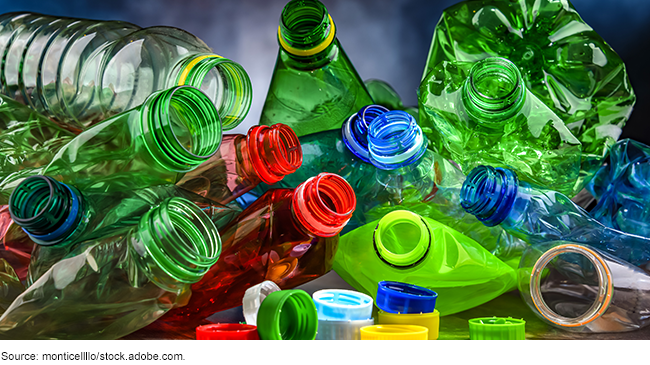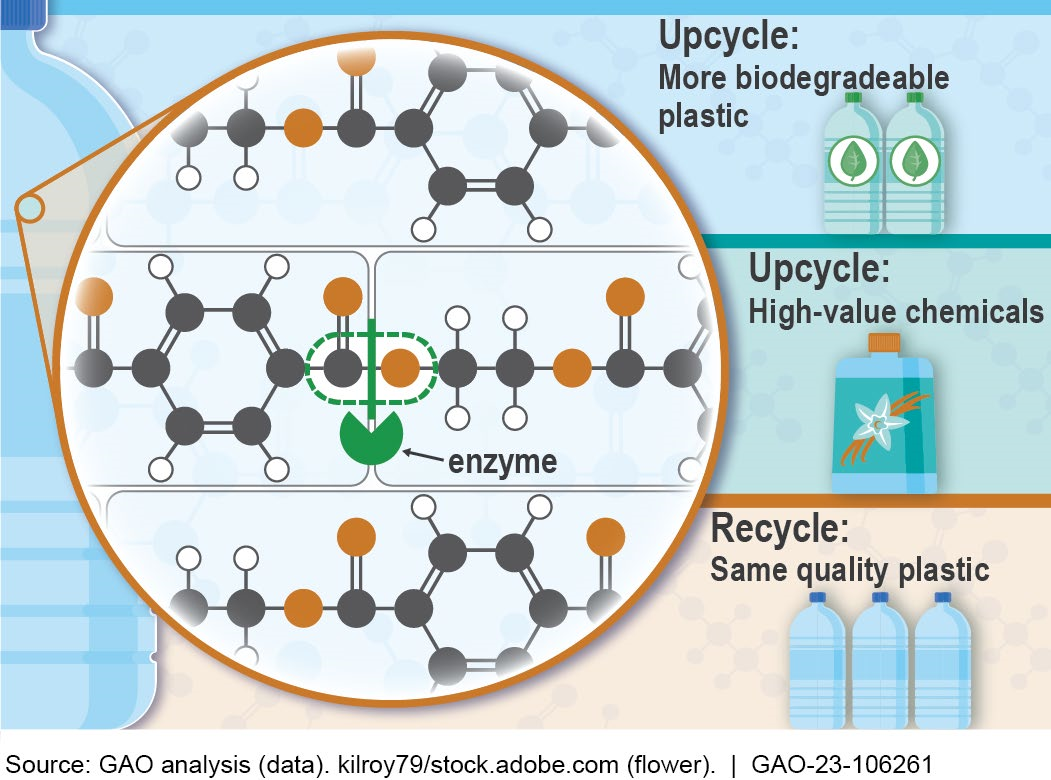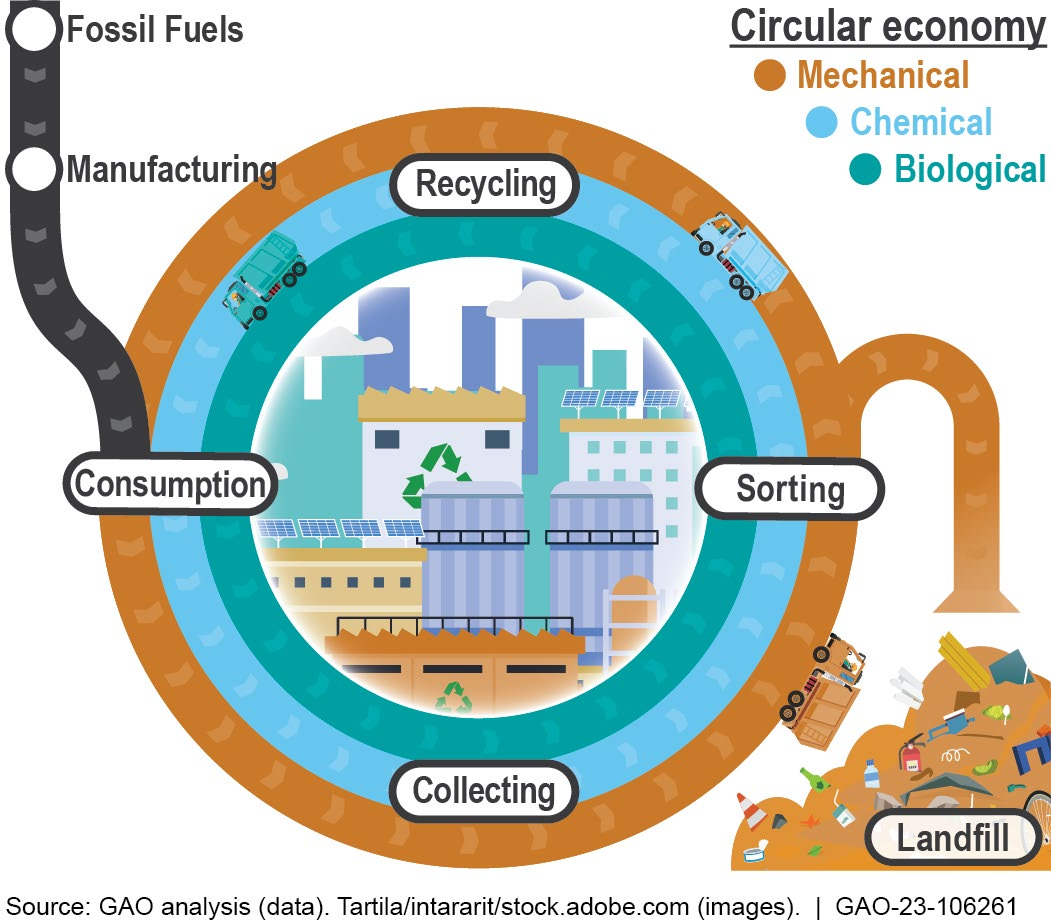Science & Tech Spotlight: Biorecycling of Plastics
Fast Facts
People around the world generated more than 350 million tons of plastic waste in 2019 and very little of it was recycled. When plastic waste ends up in landfills and the ocean, it can harm the environment and human health.
A new technology—biorecycling—may help address this problem. It uses microbes, such as bacteria or fungi, to recycle plastics.
This Science & Tech Spotlight discusses how biorecycling could benefit both the environment and the economy, and lays out the challenges that lie ahead. For example, biorecycling could turn plastic waste into more useful products but is currently limited to certain types of plastic and can be costly.

Highlights
Why This Matters
Plastic waste in landfills and oceans can have adverse environmental and health effects. More than 350 million tons of such waste was generated globally in 2019, but little of it was recycled. Biorecycling uses microbes to convert plastic waste into new products of equal or better quality. This could benefit the environment and economy, but challenges remain, including higher costs.
The Technology
What is it? Plastics, which are made primarily from fossil fuels, are widely used in products such as water bottles. Of the 353 million tons of plastic waste generated globally in 2019, nearly 70 percent was put in landfills or incinerated, according to the Organisation for Economic Co-operation and Development (OECD). According to the Environmental Protection Agency (EPA), the U.S. generated about 36 million tons of municipal plastic waste in 2018, with about 9 percent recycled.
Biological recycling, or biorecycling, is an emerging technology that uses microbes, such as bacteria or fungi, to break down plastic into its basic components for reuse. In contrast, the most commonly used recycling technology—mechanical—grinds, washes, and re-granulates the plastic. As discussed in an earlier Spotlight, chemical recycling, another emerging technology, uses heat, chemical reactions, or both to recycle plastic waste. Industry is considering advanced technologies such as biorecycling and chemical recycling as complements or alternatives to mechanical recycling. With mechanical recycling, repeated processing eventually results in lower quality plastic that is discarded in landfills.
How does it work? The microbes' specialized proteins called enzymes degrade plastic into its most basic chemical components, or monomers. The monomers can then be recombined into plastics of the same type and quality. In a process called upcycling, the monomers are recombined into different materials or chemicals with more desirable qualities, such as plastics that are more biodegradable than originally made or high-value chemicals, such as vanillin found in vanilla flavorings (see fig. 1).

Figure 1. Enzymes degrade plastic for processing into other materials, such as the same quality plastic, high-value chemicals, or more biodegradable plastic.
While some microbes have naturally evolved enzymes that can degrade certain plastics, the process in nature can take weeks or more. To make biorecycling viable at industrial scale, scientists can alter, or engineer, the natural enzyme to degrade plastics faster, reducing the time needed for complete degradation to hours.
Research suggests that biorecycling of plastics could eventually help promote a circular economy in which plastic waste is continuously reincorporated into new products. A more circular economy can lead to social, economic, and environmental benefits, including reducing plastic pollution and dependence on fossil fuels, according to experts (see fig. 2).

Figure 2. Biorecycling and chemical recycling could better support a circular economy model than mechanical recycling, which often results in lower quality plastic that is eventually discarded in landfills.
How mature is it? Of the three recycling technologies, biorecycling using engineered enzymes is the least mature. Interest in biorecycling grew after the 2016 discovery of a new species of bacteria capable of almost completely degrading polyethylene terephthalate (PET), a plastic commonly used in products such as water bottles and polyester clothes. Engineering these enzymes improves their degradation efficiency.
Most biorecycling research has focused on PET and polyurethane, partly because breaking their chemical bonds is easier. More prevalent plastics, including polyethylene (PE) and polypropylene, which are used for trash bags and containers respectively, have stronger bonds and require more energy to break them apart. However, researchers have found preliminary evidence of enzymes that can degrade PE.
GAO has previously reported that recycling is generally more expensive than making new plastics. However, according to some experts, the growing proliferation of plastic waste will continue to increase costs to society. For example, research shows that incinerating plastic waste poses negative health effects, such as lung and heart diseases. Various governments and organizations globally are exploring emerging technologies such as biorecycling. For instance, a consortium of labs supported by the European Union and China focuses on research and development in this field. Further, one company based in France has piloted a biorecycling plant that uses engineered enzymes.
In the U.S., the Department of Energy’s initiatives include a program to accelerate innovations in plastic recycling technologies. This effort involves help from other agencies, such as the National Science Foundation, Department of Agriculture, EPA, and the National Institute of Standards and Technology, which has also created the Circular Economy Program that supports research in using enzymes to degrade plastic. The Department of Defense is also exploring biorecycling to dispose of plastic waste generated by troops deployed overseas.
Entities that hope to engage in biorecycling could face a complicated legal landscape that may pose a challenge for the emerging technology. At the federal level, depending on the specifics of the process, aspects of biorecycling or the wastes that may result from that process might be governed by various laws as amended, including the Toxic Substances and Control Act of 1976; the Resource Conservation and Recovery Act of 1976; and the Microbial Products of Biotechnology Rule. In addition, states, tribal organizations, municipalities, and other stakeholders—such as nonprofit organizations, businesses, and other entities—can also play important roles in regulating or supporting recycling in the U.S.
Opportunities
- Economic, environmental, and health gains. Biorecycling of plastics could help promote a circular economy by turning waste into more useful products while reducing dependence on fossil fuels for new plastics. Also, emerging recycling methods could help mitigate the negative health effects of incinerating plastic waste.
- Processing efficiency. Biorecycling does not require the same level of sorting for plastic waste compared with mechanical recycling, thereby saving time and money. Also, it consumes less energy than mechanical and some chemical recycling methods.
Challenges
- Implementation costs. Recycling plastics is generally more expensive than creating new plastics. Further, companies may face high start-up costs to develop a biorecycling facility.
- Limited applicability. The enzymes researchers have identified are currently limited to degrading only a few types of plastic.
- Knowledge gaps. Research is needed to address the unintended consequences of biorecycling. For example, researchers have not assessed the risks engineered enzymes might pose if released into the environment.
Policy Context and Questions
- What aspects of biorecycling could be prioritized to help reduce the accumulation of plastic waste and its economic and environmental effects?
- To what extent do current laws and regulations appropriately address concerns regarding the industrial use of engineered enzymes for biorecycling, while still allowing for their development?
- What steps could the federal government, states, municipalities, and other stakeholders take if they want to support or implement effective policies for biorecycling of plastic waste?
For more information, contact Karen Howard at 202-512-6888 or HowardK@gao.gov.
